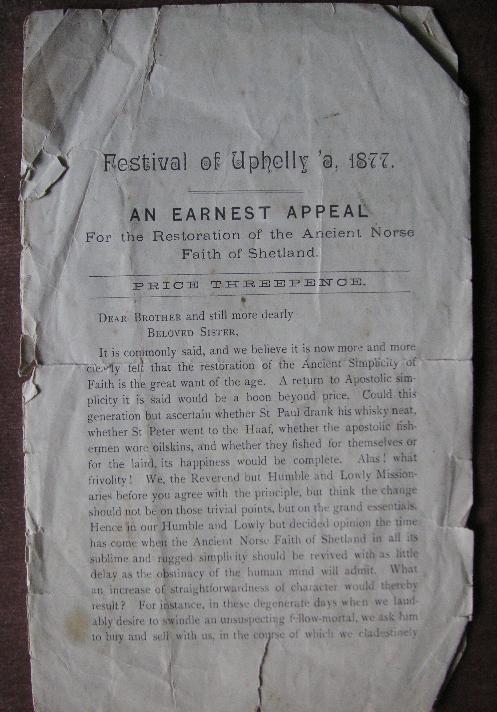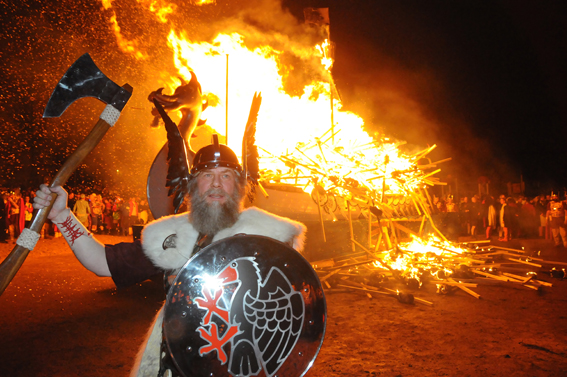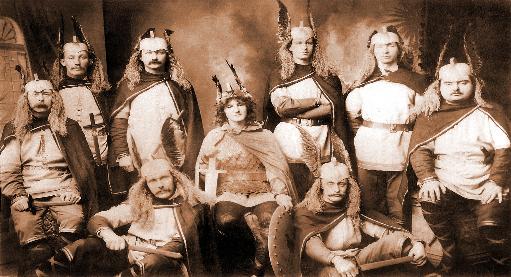Each year, the Shetland Islands host a festival of fire for the people on the island to celebrate their Nordic roots. All of the people who attend dress in chainmail and brandish swords and shields, looking like their Viking ancestors.
The crowd of dressed-up warriors stood side by side with some strange looking allies this year. There were about one thousand people dressed up as Stormtroopers.
The people who attended just to watch the celebration saw Vikings and Stormtroopers march through the Lerwick streets as the festival started. The event began with a torch-lit parade headed by the Guizer Jarl, the Viking chief. He carried an elaborately crafted wooden longship that was set on fire.
The celebration was known as Up-Helly-Aa which is a variant of the Scots’ Uphaliday. The holiday denotes Epiphany as the end of the Christmas holiday. It is held on the last Tuesday in January. The festival holds a torchlight parade, which is then followed by a fantastic finale that involves the torching of the full-sized Viking longboat.

The 1984 Guizer Jarl, Peter Malcolmson, portrayed a character entitled Eirik Bloodax Haraldson. He said that before the tradition began on the island, the celebrations in Lerwick had been much rowdier.
Since it became a tradition, it is one of the largest celebrations. There are about 1,000 or more people who attend the celebration dressed up, carrying torches, and lining the streets as the men get ready for the procession. BBC radio had said that the Shetlanders would smell the paraffin from the celebration, and that was one anticipated sign of the proud celebration.
The Guizers work four nights a week starting in October in order to build the galley and make the torches. In order to be a participant in the celebration, a person living in Shetland has to have been a resident for at least five years.

photo source: uphellyaa
The Shetland Islands are the northernmost part of the British Isles and are closer to Oslo than London. Shetland is about 105 miles northeast of the Scottish mainland. It was invaded by Vikings in the late 8th century and early 9th century. The archipelago was pledged to Scotland by the king of Norway in 1469, however, the cNorwegian spirit ontinues to show itself with street and place names being Norwegian.
Follow the link to view the photos from last year’s celebration.
A history of the celebration:
Although the celebrations are a modern festival, there is some evidence that people in Shetland have celebrated the 24th day after Christmas for a long time. However, there is no evidence that Lerwick did the same. It seems that the emergence of Yuletide and New Year festivities in the town date back to the Napoleonic Wars. It is believed the soldiers who returned home had come back with rowdy habits and the enjoyment of using firearms.
In 1824, a visiting Methodist missionary had written down his accounts on the first festival and said that the whole town was in an uproar from 12 am until the early morning hours. The men blew horns, beat drums, and beat old kettles. People joined in using anything noisy like guns, shouting, and more.

photo source: uphellyaa
As Lerwick grew in population, the celebrations became more elaborate. By 1840, the participants introduced burning tar barrels. This is most likely where the idea of fires and burning the boat stemmed from.
As stated above, the original celebrations were quite dangerous and rowdy until the public became interested in the event. Then the men cleaned up the celebrations and made them safe for the public to attend. However, during the mid-19th century the streets were quite narrow and rival groups were forced together in the middle of the processions, ending up in fights that could become quite dangerous for anyone stuck in the middle of them.
The use of tar barrels for burning ended in the 1870s when the Lerwegians decided it was time for a change. This was the beginning of a more organized event that would be taking place every year.
Source: http://www.dailymail.co.uk/news/article-3418355/Vikings-Stormtroopers-descend-Shetland-Isles-historic-boat-burning-ceremony-modern-twist.html
http://www.uphellyaa.org/about-up-helly-aa/history